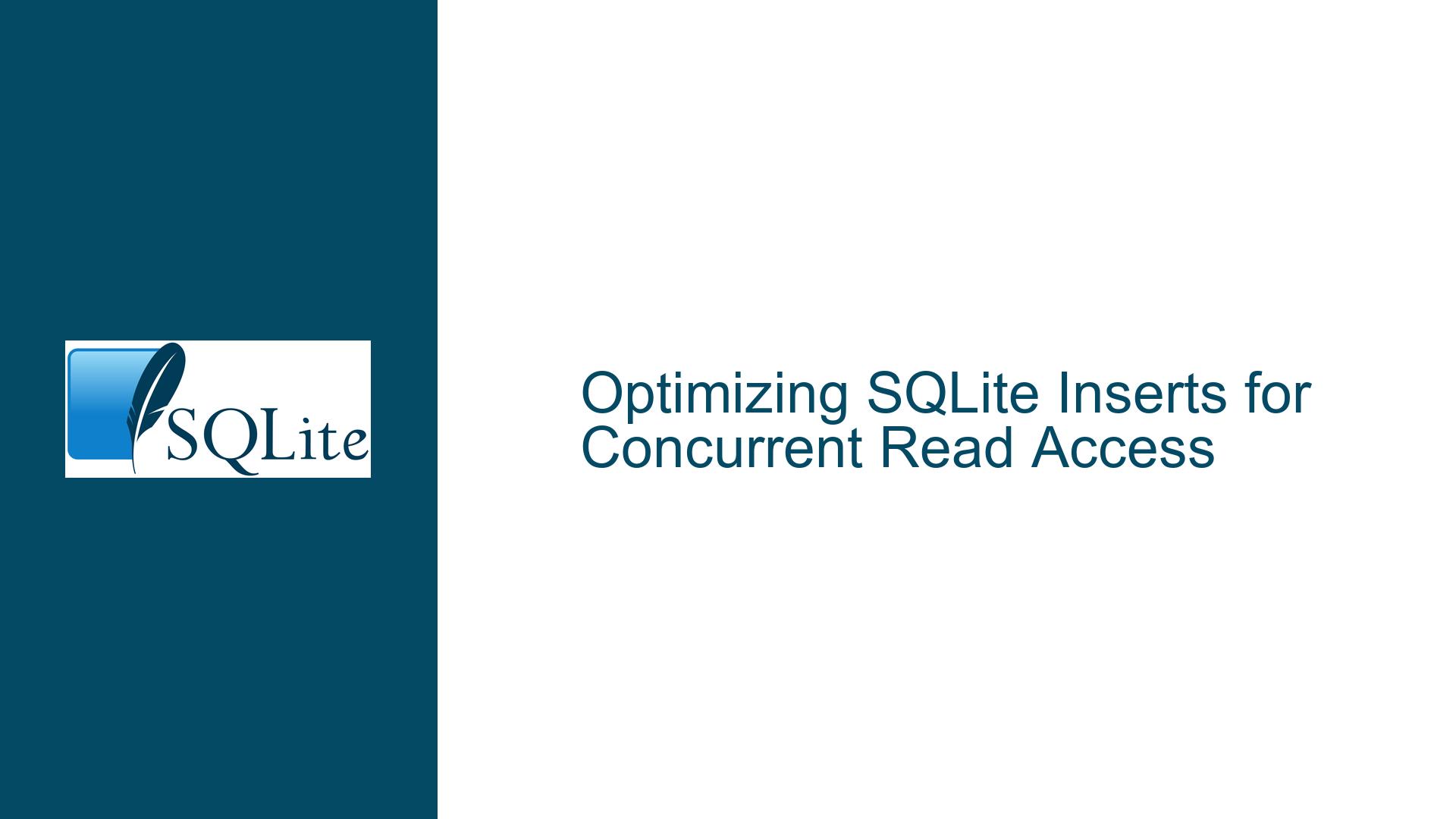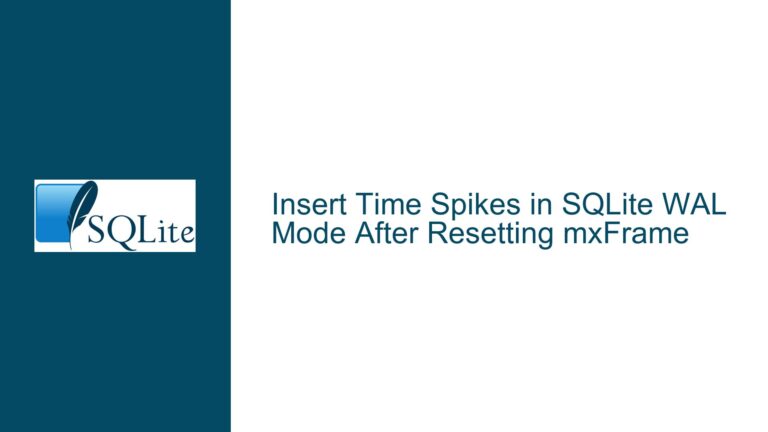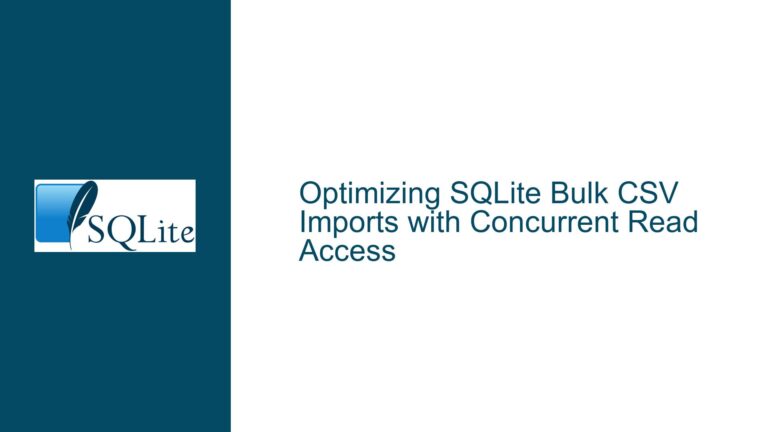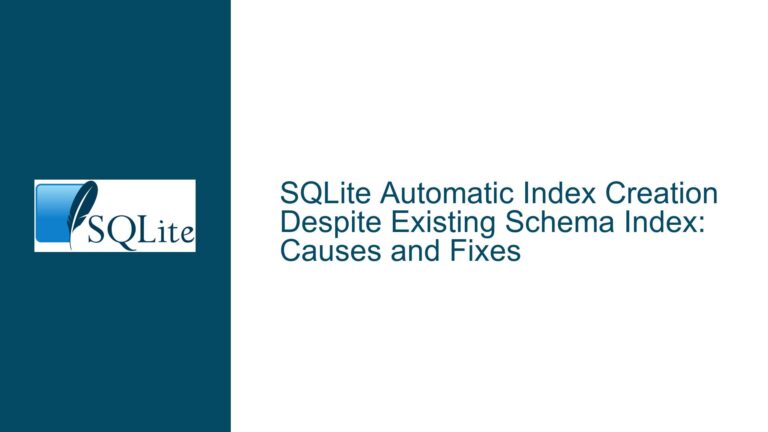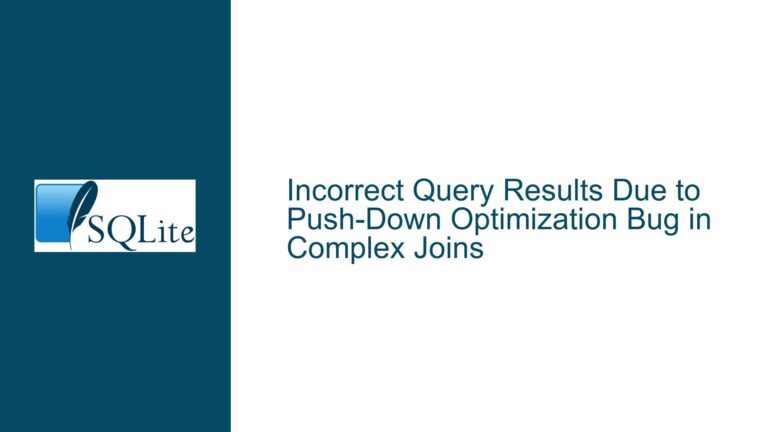Optimizing SQLite Inserts for Concurrent Read Access
Understanding SQLite’s Concurrency Model During Bulk Inserts
SQLite is a lightweight, serverless database engine that is widely used in applications requiring embedded database functionality. One of the key challenges when working with SQLite, especially in multi-process environments, is managing concurrent access to the database. Specifically, the issue of allowing reading by another process while inserting many entries is a common concern. This post delves into the intricacies of SQLite’s concurrency model, the factors that influence read access during bulk inserts, and the strategies to optimize performance without compromising data integrity.
SQLite employs different journaling modes to manage transactions, with the two most common being the rollback-journal mode and the Write-Ahead Logging (WAL) mode. Each mode has distinct behaviors regarding how reads and writes are handled, particularly during bulk insert operations. Understanding these behaviors is crucial for designing efficient database operations that minimize blocking and ensure smooth concurrent access.
In rollback-journal mode, SQLite uses a traditional journaling mechanism where changes to the database are first written to a separate journal file. During a transaction, other processes can still read from the database, but there are specific points, particularly during the COMMIT phase, where read operations may be blocked. This blocking is typically short-lived, but in scenarios involving large transactions that exceed SQLite’s page cache, the blocking duration can extend significantly.
On the other hand, WAL mode offers a more concurrency-friendly approach. In WAL mode, changes are appended to a write-ahead log file rather than directly modifying the database file. This allows readers to continue accessing the database without being blocked by writers, except for a brief moment during the COMMIT operation when the WAL file is updated. However, readers will not see the changes made by the writer until the transaction is committed.
The choice between these modes, along with the configuration of SQLite’s cache settings, plays a pivotal role in determining the performance and concurrency characteristics of your database operations. The following sections explore the possible causes of read blocking during bulk inserts and provide detailed troubleshooting steps and solutions to mitigate these issues.
Factors Influencing Read Blocking During Bulk Inserts
Several factors can influence the extent to which read operations are blocked during bulk inserts in SQLite. These factors include the journaling mode, the size of the transaction, the configuration of SQLite’s page cache, and the presence of long-running read transactions.
Journaling Mode: As mentioned earlier, the journaling mode significantly impacts how SQLite handles concurrent reads and writes. In rollback-journal mode, the database is locked during the COMMIT phase, which can block read operations. In contrast, WAL mode allows readers to access the database without being blocked by writers, except during the brief COMMIT phase. Therefore, using WAL mode is generally recommended for applications requiring high concurrency.
Transaction Size: The size of the transaction, in terms of the number of rows being inserted, also affects read blocking. In rollback-journal mode, if the transaction size exceeds the capacity of SQLite’s page cache, the database will spill the excess data to disk, leading to extended periods of read blocking. This is because the database must write the changes to disk before allowing other processes to read. In WAL mode, the impact of transaction size on read blocking is less pronounced, but large transactions can still lead to increased contention and potential performance degradation.
Page Cache Configuration: SQLite’s page cache, controlled by the cache_size and cache_spill PRAGMAs, plays a crucial role in managing the performance of bulk inserts. The cache_size PRAGMA determines the maximum number of database pages that can be held in memory, while the cache_spill PRAGMA controls when the cache spills to disk. Properly configuring these settings can help minimize the impact of large transactions on read operations. For example, increasing the cache_size can reduce the frequency of cache spills, thereby reducing the duration of read blocking in rollback-journal mode.
Long-Running Read Transactions: Another factor that can cause extended read blocking is the presence of long-running read transactions. When a writer attempts to COMMIT a transaction, it must wait for all active readers to complete before it can update the database. During this time, new readers are not allowed to start, which can lead to writer starvation and increased blocking times. To mitigate this issue, it is important to design your application to minimize the duration of read transactions and avoid holding read transactions open for extended periods.
Strategies to Minimize Read Blocking During Bulk Inserts
To minimize read blocking during bulk inserts in SQLite, several strategies can be employed, including optimizing transaction size, configuring the page cache, using WAL mode, and managing long-running read transactions.
Optimizing Transaction Size: One of the most effective ways to reduce read blocking is to optimize the size of your transactions. Instead of inserting all rows in a single large transaction, consider breaking the insert operation into smaller transactions. This approach reduces the amount of data that needs to be written to disk at once, thereby minimizing the duration of read blocking. For example, instead of inserting 10,000 rows in one transaction, you could insert 1,000 rows in each of 10 smaller transactions. This strategy is particularly effective in rollback-journal mode, where large transactions can lead to extended blocking periods.
Configuring the Page Cache: Properly configuring SQLite’s page cache can also help reduce read blocking. By increasing the cache_size PRAGMA, you can allow more database pages to be held in memory, reducing the frequency of cache spills and the associated read blocking. Additionally, adjusting the cache_spill PRAGMA can help control when the cache spills to disk, allowing you to fine-tune the balance between memory usage and disk I/O. It is important to note that increasing the cache size will consume more memory, so you should ensure that your system has sufficient resources to accommodate the larger cache.
Using WAL Mode: Switching to WAL mode is one of the most effective ways to improve concurrency in SQLite. In WAL mode, readers are not blocked by writers, except during the brief COMMIT phase. This allows for smoother concurrent access to the database, particularly in applications with a high volume of read operations. To enable WAL mode, you can use the following command: PRAGMA journal_mode=WAL;. Once WAL mode is enabled, you should see a significant reduction in read blocking during bulk inserts.
Managing Long-Running Read Transactions: To avoid extended read blocking caused by long-running read transactions, it is important to design your application to minimize the duration of these transactions. One approach is to use short-lived read transactions that are opened and closed quickly, rather than holding a read transaction open for an extended period. Additionally, you can use the BEGIN IMMEDIATE or BEGIN EXCLUSIVE transaction modes to ensure that writers are given priority over readers, reducing the likelihood of writer starvation.
Monitoring and Tuning: Finally, it is important to monitor the performance of your database and tune the configuration as needed. SQLite provides several PRAGMAs and commands that can help you monitor the performance of your database, including the sqlite3_status function, which provides information on the current state of the database, and the EXPLAIN QUERY PLAN command, which can help you analyze the performance of your queries. By regularly monitoring and tuning your database, you can ensure that it continues to perform well as your application evolves.
In conclusion, managing concurrent read access during bulk inserts in SQLite requires a deep understanding of the database’s concurrency model and the factors that influence read blocking. By optimizing transaction size, configuring the page cache, using WAL mode, and managing long-running read transactions, you can minimize read blocking and ensure smooth concurrent access to your database. Additionally, regular monitoring and tuning of your database will help you maintain optimal performance as your application grows.
